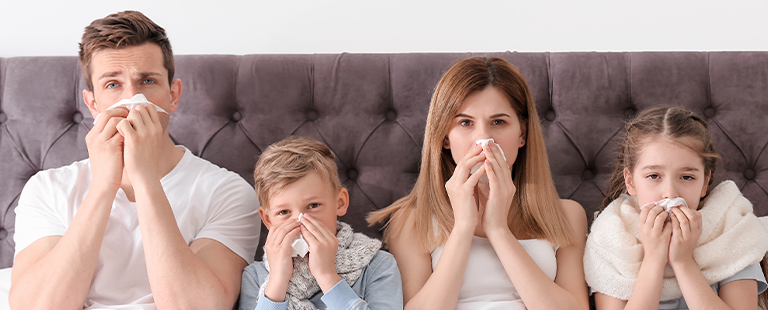How often does one experience a cold or flu?
Did you know that colds and flus are the most common infections in human beings? On average, adults catch around 2-5 colds per year, while children can catch around 7-10 each year. Because of how often we can catch them and how easily transmissible they are, colds and flus are the most common reason that people need to take time off from work and school.
Colds and flus are caused by viruses and their symptoms are quite similar:
- Runny noses and/or nasal congestion
- Sore throat
- Fatigue
- Fever
Most people will typically recover from a cold or flu within 7-10 days, however, symptoms of cold or flu can interrupt our daily lives, so if your symptoms persist, see a health professional.
How can I prevent getting sick with a cold or the flu?
The way we live our lives day-to-day, you may never be able to prevent getting sick in its entirety, however there are measures one can take which may reduce the exposure to illness and help reduce the severity, frequency, and duration. As colds and flus are so easily transmissible between people as well as from surfaces, maintaining good hygiene is important to help prevent you, your family and those in your school and workplace from getting sick.
Regularly washing your hands, coughing and sneezing into a tissue, and wiping down common surfaces like door handles, desks and eating areas are some examples of hygienic practices to help prevent infection from a cold or flu.
You can also supplement with immune-specific nutrients and herbs, such as:
- Zinc – which is important for the functioning of neutrophils, the white blood cells that are the first cells to respond to foreign pathogens in the body
- Vitamin C – which helps to reduce the duration of colds and flus, helping to get us back on our feet quicker when sick
- Elderberry – a herbal medicine that reduces common symptoms of colds and flus like a runny nose, sore throat, cough and fatigue
Does diet affect your chances of contracting illness?
Yes, our diet can certainly affect our chances of getting sick! Our bodies require optimal levels of specific nutrients for effective immune system function to help reduce severity, frequency, and to also help us recover as quickly as possible when we do get sick.
Along with practicing good hygiene and supplementing with immune-specific nutrients and herbs, eating a balanced and varied diet (hyperlink immunity article) can support healthy immune function. Here are some foods to enjoy to help prevent your chances of getting sick:
- Red Capsicum – did you know that just one square inch piece of capsicum contains your daily intake of vitamin C? We know that vitamin C helps reduce the duration of colds and flu and it also plays a role in preventing illness, so consider adding some red capsicum into your salads or as a snack with your favourite dip
- Garlic – garlic has a long history of use as an antimicrobial agent, especially for upper respiratory tract infections like colds and flus, targeting symptoms like coughs and nasal congestion. Add garlic to your soups, pasta sauces and salad dressing for extra flavour, as well as all the benefits it has to offer
- Protein-rich foods – protein is a macronutrient that is important for our immune system as it helps with the production of our white blood cells that target and destroy pathogens in the body. Sources of protein come from animals, like chicken, eggs and cheese, and also from plants like tofu, beans and nuts
- Fermented foods – interestingly, most of our immune cells are manufactured in our gut, so supporting gut health will in turn help our immune system. Fermented foods are sources of probiotics that support both our gut cells and immune cells. Some examples of fermented foods to enjoy in your diet are yoghurt, sauerkraut and kombucha
REFERENCES
Eccles, R. (2005), Understanding the Symptoms of the Common Cold and Influenza, The Lancet Infectious Diseases 5(11): 718-725, accessed 16.03.2022, doi: 10.1016/S1473-3099(05)70270-X
Thomsen, M., Gennat, H. (2009), Phytotherapy Desk Reference, pp.18-19, Global Natural Medicine Pty Ltd
Other Products in the Range
1 Item
-
 Sambucol Adult Cough Liquid 250mLOut of stock
Sambucol Adult Cough Liquid 250mLOut of stock
1 Item


